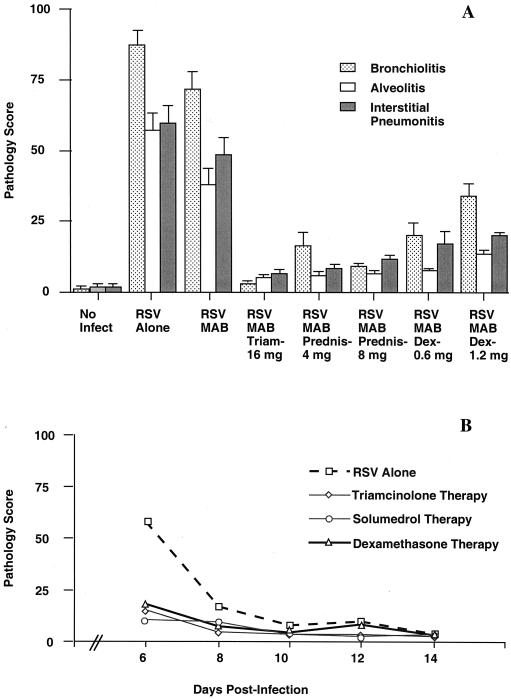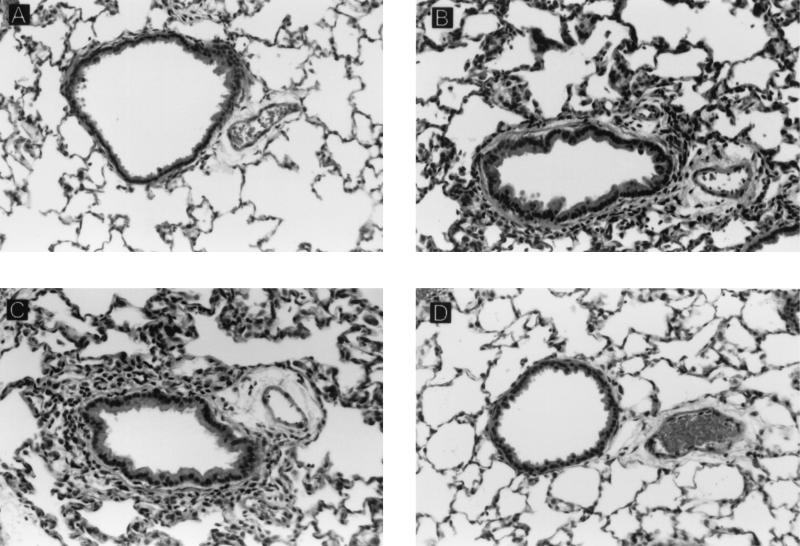Abstract
Triamcinolone acetonide, methylprednisolone, and dexamethasone were each evaluated in combination with palivizumab (Synagis) for the therapy of established respiratory syncytial virus infection in the cotton rat. Triamcinolone and methylprednisolone proved to be more effective than dexamethasone in reducing lung pathology. No recurrence of viral replication or pulmonary pathology followed the cessation of therapy.
The cotton rat model of respiratory syncytial virus (RSV) infection has been used for over 20 years to study the pathogenesis and potential therapy of RSV (7). This animal model was invaluable in proving the protective efficacy of anti-RSV antibody (6) and led to the development of RSV immunoglobulin (RespiGam; Medimmune, Inc., Gaithersburg, Md.) and palivizumab (Synagis; Medimmune) for the prevention of severe RSV infection of the lower respiratory tract (1, 2, 5). These preparations have been less effective when used therapeutically (9, 10). Recent experiments with cotton rats demonstrated that combined systemic therapy with palivizumab and triamcinolone acetonide, a potent glucocorticoid, greatly reduced inflammatory changes and viral replication in animals infected with RSV but that palivizumab alone reduced viral titers without altering the degree of inflammation (8). Systemic triamcinolone acetonide is rarely used in the treatment of pediatric respiratory disease, and therefore we examined the comparative efficacies of triamcinolone acetonide, methylprednisolone, and dexamethasone when each was used in combination with palivizumab in the treatment of experimental RSV infection.
(This work was presented in part at the 70th Meeting of the Society for Pediatric Research, Baltimore, Md., May 2001 [Pediatr. Res. Program issue APS-SPR 43:A1359].)
Animals
Sigmodon hispidus cotton rats were obtained from a breeding colony maintained at Virion Systems, Incorporated, Rockville, Md.
Virus
A pool of the prototypic Long strain of RSV (American Type Culture Collection, Manassas, Va.) which contained 107.5 PFU/ml was used for all experiments. Pulmonary virus titers were determined by plaque assay as described previously (7).
Monoclonal antibody and glucocorticoids
Palivizumab was provided by Medimmune, Inc. Triamcinolone acetonide (Steris Laboratories, Phoenix, Ariz.) was administered as a single daily intramuscular (i.m.) dose of 16 mg/kg of body weight, a dose previously found to be highly effective in reducing pulmonary pathology (8). Dexamethasone (Elkins-Sinn, Cherry Hill, N.J.) was administered in a single daily intraperitoneal (i.p.) dose of 0.6 or 1.2 mg/kg. Methylprednisolone (Solu-Medrol; Phamacia and Upjohn, Kalamazoo, Mich.) was administered in a total daily dose of 4 or 8 mg/kg divided into four equal i.p. injections.
Histopathology
Lungs were inflated to their normal volume with 10% formalin. Hematoxylin- and eosin-stained slides were prepared from coronal paraffin-embedded sections and scored for peribronchiolitis (inflammatory cells around small airways), interstitial pneumonitis (inflammatory cell infiltration and thickening of alveolar walls), and alveolitis (inflammatory cells within the alveolar spaces). Slides were scored in a blind manner by three investigators using a scale ranging from 0 (no inflammatory changes) to 100 (maximum inflammation).
Statistical analysis
A viral titer was expressed as the geometric mean ± standard error for all animals in a group. The two-tailed Student t test, using summary data, was used to determine the significance of differences between groups. The number of histologic lesions was expressed as an arithmetic mean ± the standard error of the numbers of lesions for all animals in a group. Statistical analysis of composite histology scores was not done, since the data are disparate.
Comparative efficacies of different steroids
Six groups of eight or nine cotton rats were intranasally infected with 106.5 PFU of RSV Long and given one i.m. dose of palivizumab (15 mg/kg) 3 days later. Five of these groups received glucocorticoid therapy as described above on days 3, 4, and 5 postinfection. All animals, including those in a seventh uninfected group, were sacrificed for histopathological evaluation on day 6 after infection, and the results are summarized in Fig. 1A. As we reported earlier, therapy with palivizumab alone did not reduce pathology (8). Triamcinolone acetonide and either dose of methylprednisolone reduced the pathologic changes to nearly baseline levels. Dexamethasone at either dose was less effective in reducing inflammation, particularly peribronchiolitis. Representative lung photomicrographs are shown in Fig. 2.
FIG. 1.
(A) Arithmetic mean pulmonary pathology scores (plus standard errors) for degrees of bronchiolitis, alveolitis, and interstitial pneumonitis seen in cotton rats on day 6 after experimental infection with 106.5 PFU of RSV (excluding values for the uninfected controls) after receiving the therapy indicated. Each group contained eight or nine animals. No Infect, uninfected controls; MAB, monoclonal antibody; Triam, triamcinolone; Prednis, methylprednisolone; Dex, dexamethasone. (B) Composite pathology scores (arithmetic means) after infection with 106.5 PFU of RSV, with sampling of pulmonary histopathology on days 6, 8, 10, 12, and 14 after the rats received the therapy indicated. Each indicated data point represents a mean value for three or four animals.
FIG. 2.
(A) Uninfected cotton rat lung. (B) Untreated RSV infection on day 6. Note the significant components of peribronchiolitis, interstitial pneumonia, and alveolitis with a predominating mononuclear infiltrate. (C) RSV infection on day 6 after treatment with palivizumab alone on day 3. Little or no improvement is apparent compared to untreated infected lung tissue. (D) RSV infection on day 6, after treatment with palimizumab on day 3 and methylprednisolone (4 mg/kg) on days 3, 4, and 5. Note the reduction in inflammatory infiltrates to levels near those of the uninfected control in panel A. All photomicrographs are of hematoxylin- and eosin-stained lung at a magnification of ×64.
Recurrence of virus replication or pathologic changes
Four groups of 20 cotton rats each were infected intranasally with 106.5 PFU of RSV Long. On the third day postinfection, animals in three of the groups received one i.m. dose of palivizumab (15 mg/kg) and concurrent glucocorticoid therapy on days 3, 4, and 5 in the following doses: for triamcinolone acetonide, 16 mg/kg i.m. once daily; for methylprednisolone, 4 mg/kg administered as 1 mg/kg i.p. every 6 h; or for dexamethasone, 0.6 mg/kg i.p. once daily. Animals were sacrificed on days 6, 8, 10, 12, and 14 postinfection for viral titration and histopathology.
Inflammation following untreated RSV infection was significant on day 6 postinfection and slowly abated over the subsequent 8 days (Fig. 1B). All three glucocorticoid-treated groups had greater reductions in pathology; no group had a recurrence of histopathology over the 2-week period. On day 6, 102.5 PFU of RSV per g was recovered from the lungs of untreated animals, while 103 PFU/g was recovered from the lungs of triamcinolone-palivizumab-treated animals on days 6 and 8 of experimental infection. No further viral replication was detected in any groups during the remainder of the experiment. This scant level of viral replication eliminated the need for comparative statistical analysis of viral titrations.
In recent years, there has been a realization that the therapy of certain infectious diseases needs to target both the infectious agent and host inflammation. The results of trials using glucocorticoids to treat RSV disease are mixed, with some trials suggesting the efficacy of such treatment and others showing no benefit (4). The types and doses of corticosteroids have been sufficiently varied to make the interpretation of results extremely difficult. A similar long-standing debate about the effectiveness of corticosteroid treatment of viral croup was resolved in 1989 when a meta-analysis of all reported clinical trials suggested that the type and dose of corticosteroid were critical factors in determining the outcome (3), a conclusion reinforced by the publication of a well-designed, double-blind, placebo-controlled study which demonstrated a significant benefit from a large dose of dexamethasone (11). In this series of experiments, triamcinolone and methylprednisolone were more effective than dexamethasone and lacked adverse effects; they also reduced pulmonary histopathology in RSV-infected cotton rats by equal amounts.
These experiments were conducted with drugs already licensed by the Food and Drug Administration and in common pediatric usage. The novelty of our approach is the combination of these two types of drugs, an antiviral agent along with an anti-inflammatory agent, to treat viral pneumonia. Though cotton rats do not exhibit overt clinical disease, this animal model has a proven track record of predicting the outcomes of several RSV interventions. We feel that the findings of this study demonstrating the efficacy and safety of our approach in the cotton rat model, provide the rationale for clinical trials of combined therapy.
The opinions and assertions contained herein are those of the authors alone and do not reflect the views of the Uniformed Services University, The United States Air Force, or The Department of Defense.
Acknowledgments
This work was supported in part by USUHS research grants RO86CM and RO86DM.
REFERENCES
- 1.Groothuis, J. R., E. A. F. Simoes, M. J. Levin, C. B. Hall, C. E. Long, W. J. Rodriguez, J. Arrobio, H. C. Meissner, D. R. Fulton, R. C. Welliver, D. A. Tristam, G. R. Siber, G. A. Prince, M. Van Raden, V. G. Hemming, and the Respiratory Syncytial Virus Immune Globulin Study Group. 1993. Prophylactic administration of respiratory syncytial virus immune globulin to high-risk infants and young children. N. Engl. J. Med. 329:1524-1530. [DOI] [PubMed] [Google Scholar]
- 2.The IM-pact RSV Study Group. 1998. Palivizumab, a humanized respiratory syncytial virus monoclonal antibody, reduces hospitalization from respiratory syncytial virus infection in high-risk infants. Pediatrics 102:531-537. [PubMed] [Google Scholar]
- 3.Kairys, S. W., E. M. Olmsted, and G. T. O'Conner. 1989. Steroid treatment of laryngotracheitis: a meta-analysis of the evidence from randomized trials. Pediatrics 83: 683-693. [PubMed] [Google Scholar]
- 4.Ottolini, M. G., and V. G. Hemming. 1997. Prevention and treatment recommendations for respiratory syncytial virus infection. Drugs 54: 867-884. [DOI] [PubMed] [Google Scholar]
- 5.PREVENT Study Group. 1997. Reduction of respiratory syncytial virus hospitalization among premature infants and infants with bronchopulmonary dysplasia using respiratory syncytial virus immune globulin prophylaxis. Pediatrics 99:93-99. [DOI] [PubMed] [Google Scholar]
- 6.Prince, G. A., V. G. Hemming, R. L. Horswood, and R. M. Chanock. 1985. Immunoprophylaxis and immunotherapy of respiratory syncytial virus in the cotton rat. Virus Res. 3: 193-206. [DOI] [PubMed] [Google Scholar]
- 7.Prince, G. A., A. B. Jenson, R. L. Horswood, E. Camargo, and R. M. Chanock. 1978. The pathogenesis of respiratory syncytial virus infection in cotton rats. Am. J. Pathol. 93: 771-791. [PMC free article] [PubMed] [Google Scholar]
- 8.Prince, G. A., A. Mathews, S. J. Curtis, and D. D. Porter. 2000. Treatment of respiratory syncytial virus bronchiolitis and pneumonia in a cotton rat model with systemically administered monoclonal antibody (palivizumab) and glucocorticosteroid. J. Infect. Dis. 182: 1326-1330. [Google Scholar]
- 9.Rodriguez, W. J., W. C. Gruber, J. R. Groothuis, E. A. Simoes, A. J. Rosas, M. Lepow, A. Kramer, and V. G. Hemming. 1997. Respiratory syncytial virus immune globulin treatment of RSV lower respiratory tract infection in previously healthy children. Pediatrics 100: 937-942. [DOI] [PubMed] [Google Scholar]
- 10.Rodriguez, W. J., W. C. Gruber, R. C. Wellever, J. R. Groothuis, E. A. Simoes, H. C. Meissner, V. G. Hemming, C. B. Hall, M. L. Lepow, A. J. Rosas, C. Robertsen, A. A. Kramer, and the Respiratory Syncytial Virus Immune Globulin Study Group. 1997. Respiratory syncytial virus (RSV) immune globulin intravenous therapy for RSV lower respiratory tract infection in infants and young children at high risk for severe RSV infections. Pediatrics 99: 454-461. [DOI] [PubMed] [Google Scholar]
- 11.Super, D. M., N. A. Cartelli, L. J. Brooks, R. M. Lembo, and M. L. Kumar. 1989. A prospective randomized double-blind study to evaluate the effect of dexamethasone in acute laryngotracheitis. J. Pediatr. 115: 323-329. [DOI] [PubMed] [Google Scholar]




